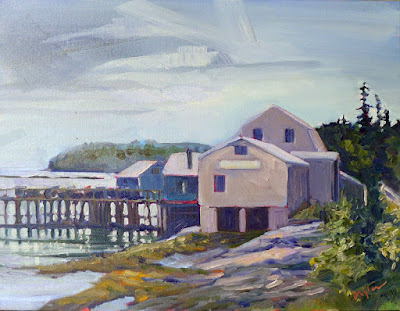Landscape tells us about our existence, our relationships with each other, and ultimately our relationship with God.
|
Deadwood, 36X48, oil on canvas, Carol L. Douglas
|
God+Man
Carol L. Douglas Studio
394 Commercial Street
Rockport, ME 04856
Saturday, February 29, 2020
2 to 5 PM
Painting is a solitary business, which gives you plenty of time to think. At the same time, it’s a form of communication, so it ought to attract people with something to say. That creates a constant pull between seeing and saying, making and showing.
I do as much of my painting as I can outdoors. That inevitably gives me time to think about what the view in front of me means. Landscape tells us about our existence, our relationships with each other, and ultimately our relationship with God. This visible record is subtle, but once you start to notice it, you realize it’s everywhere.
The work in this display was made for an invitational show at the Davison Gallery at Roberts Wesleyan College. It was conceived as a faith statement. This isn’t too much of a reach. God is obviously there in every tree, cloud and sunset. Man is nearly as ubiquitous.
 |
|
All flesh is as grass, 36X48, oil on canvas, Carol L. Douglas
|
This was just before I moved to Maine for good. I was working summers here teaching and painting. In mid-October, I went home to Rochester to paint the work for this show. What wasn’t on my schedule was a second cancer diagnosis.
I made my canvases during the four-week recovery period between surgeries. As always, I drenched the canvases with Naphthol Red. This is an excellent undertone for landscape, and my students will recognize it as standard practice for my plein air painting. However, the effect of all that red on those looming large canvases was making me slightly queasy.
Something wasn’t quite right. I was bleeding internally, and in early February I hemorrhaged. This same thing had happened during my cancer treatment in 2000; in both cases, blood loss laid me low in a way my treatment never did.
I ultimately realized there was a connection between this health crisis and the paintings, which were proceeding by starts and fits. Over the summer, I had sketched each canvas out in smaller form. It was supposed to be a simple matter of gridding them up and painting big, but I was having trouble getting them done in the allotted time. In the end, I let the canvas show through, because they were literally born in blood.
|
Beauty instead of ashes, 36X48, oil on canvas, Carol L. Douglas
|
Included in this show are several scenes familiar to midcoast Maine viewers, including northern lights over Owls Head and the lime tailings at Rockport.
By the Civil War, midcoast Maine was producing more than a million casks of lime a year. The evidence of this industry is still all over our communities, including in the lime tailings along the Goose River. Although this lime is benign, it is a symbol of greater damage elsewhere. Environmental damage is not just a metaphor for sin; it’s a form of sin itself. The damage take a long time to heal.
The opening is on Saturday, February 29, from 4 to 6 PM, at my studio, 394 Commercial Street, Rockport. The public is invited.







